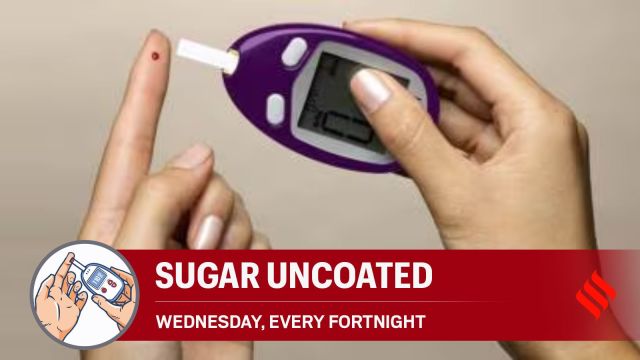Eating too fast can spike your blood sugar: Here’s why slowing down matters
Taking smaller bites, chewing more, putting plates down between bites and avoiding rushed meals give the digestive system time to regulate glucose release
 How quickly we eat influences how the body manages blood glucose after a meal. Eating fast does not cause diabetes on its own but it can lead to higher post-meal glucose peaks. (File)
How quickly we eat influences how the body manages blood glucose after a meal. Eating fast does not cause diabetes on its own but it can lead to higher post-meal glucose peaks. (File)Are you one of those who prefer grab-and-go lunches, simply because you can gulp them down easily and get some work done in between? Then you are like this 38-year-old executive who came to see me complaining of sharp post-meal glucose spikes. He often finished lunch in under ten minutes due to a tight schedule. His meals usually included rice, curry and salad. Because he ate quickly, he had larger mouthfuls and chewed less. His energy rose momentarily but then he crashed, feeling exhausted.
How quickly we eat influences how the body manages blood glucose after a meal. Eating fast does not cause diabetes on its own but it can lead to higher post-meal glucose peaks. This happens because of how digestion, chewing and hormonal signalling work together.
Why fast eating raises blood sugar
Digestion starts in the mouth. Chewing breaks food into smaller pieces and mixes it with saliva, which contains enzymes that begin carbohydrate breakdown. When food is swallowed quickly with minimal chewing, the stomach and small intestine receive larger pieces of food sooner and need to work harder to break them down. This can speed up the release of glucose into the bloodstream, especially when the meal contains refined carbohydrates.
The body relies on gut hormones to regulate appetite and insulin release. These include incretin hormones such as GLP-1 and GIP, which help the pancreas release insulin in a timely manner. Slow eating gives these hormonal responses enough time to activate. When eating is very fast, food reaches the intestine before these signals are fully triggered, which can lead to a sharper rise in blood glucose. This effect has been documented in clinical studies that show slower eating is associated with lower post-meal glucose levels.
Why portion size matters
Portion size also plays a role. The brain takes time to register fullness. People who eat quickly often consume more before satiety signals reach the brain. A larger meal naturally delivers more glucose, increasing the chance of a higher post-meal spike. Speed leads to increased intake.
Another supported observation is that faster eating is linked to higher overall energy intake and body weight. Excess weight increases the risk of insulin resistance. This means that over time, a repeated pattern of fast eating can contribute indirectly to poorer glucose control.
How to avoid post-meal spikes
A dietitian advised the executive to slow his pace, chew more thoroughly and allow at least 15 to 20 minutes for a meal. When he followed this formula, not only could he control his portion sizes, he noticed fewer energy fluctuations. His follow-up post-meal reading showed a milder rise compared to earlier.
Simple changes can help. Taking smaller bites, chewing more, putting plates down between bites and avoiding rushed meals give the digestive system time to regulate glucose release. Choosing foods that require more chewing, such as whole grains and vegetables, also slows the process naturally.
Eating too fast may look harmless, but the relationship between meal speed and blood glucose is well-documented. Slowing down does not require major lifestyle changes. It simply allows the body’s natural systems to work as intended, supporting steadier post-meal glucose levels and better long-term metabolic health.
(Dr Saptarshi Bhattacharya is senior consultant, endocrinology, Indraprastha Apollo Hospitals, Delhi)



- 01
- 02
- 03
- 04
- 05




























